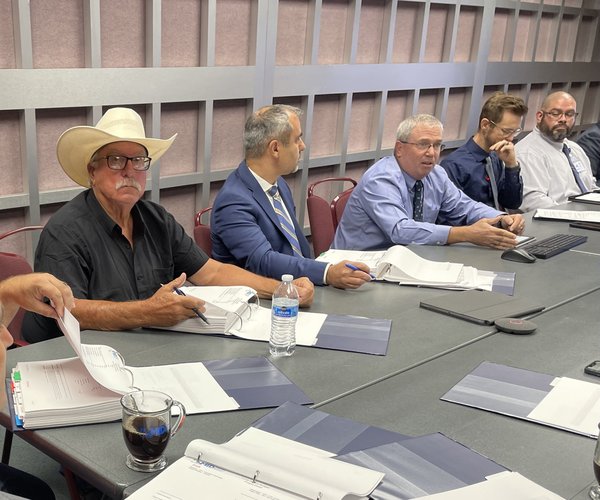Before the ball drops in Times Square and the roller coaster of a presidential election year begins, it’s time to take one last look back at the top local stories of 2023.
The year began with a deluge of rain and didn’t stop, making for a huge swing from extreme drought in 2022 to a record-breaking precipitation year in 2023. The year was also a big one for local drinking water, as the much-anticipated surface water treatment plant finally opened in November.
Turlock welcomed back one of its iconic eateries in Latif’s and said goodbye to a huge supporter of downtown Turlock and the entire business community, with the passing of Sharon Silva.
Here is a brief roundup of a few top moments from 2023:

Water year ends as third-wettest in history
The 2022-23 water year didn’t get off to a roaring start, but it turned out to be third-wettest year since Turlock Irrigation District began keeping records in 1897.
With 4.13 million acre-feet of runoff, 2023 ranked behind 2017 (4.6 million acre-feet) and 1983 (4.6 million acre-feet).
On average, the Tuolumne River Watershed gets about 2 million acre-feet per water year, which starts on Oct. 1 and concludes on Sept. 30. To bring that into finer focus, Don Pedro Reservoir can store 2,000,030 acre-feet of water. So, 2023 provided more than double the usual amount of precipitation and more than double what Don Pedro Reservoir can handle.
At the Department of Water Resources’ fourth snow survey of the season at Phillips Station. The manual survey recorded 126.5 inches of snow depth and a snow water equivalent of 54 inches, which was 221 percent of average for the location on April 3.
The April result from the statewide snow sensor network was higher than any other reading since the snow sensor network was established in the mid-1980s. Before the network was established, the 1983 April 1 statewide summary from manual snow course measurements was 227 percent of average. The 1952 April 1 statewide summary for snow course measurements was 237 percent of average.
“This year’s result will go down as one of the largest snowpack years on record in California,” said Sean de Guzman, manager of DWR’s Snow Surveys and Water Supply Forecasting Unit, in an April press release.
For California’s snow course measurements, only 1952, 1969 and 1983 recorded statewide results above 200 percent of the April 1, 2023 average. While above average across the state, snowpack varied considerably by region. The Southern Sierra snowpack was 300 percent of its April 1 average and the Central Sierra was at 237 percent of its April 1 average. However, the critical Northern Sierra, where the state’s largest surface water reservoirs are located, was at 192 percent of its April 1 average.
The size and distribution of this year’s snowpack also posed severe flood risk to areas of the state, especially the Southern San Joaquin Valley.
In fact, flooding resulted in massive property damage and at least 22 fatalities. At least 200,000 homes and business lost power during the December-January storms and 6,000 individuals were ordered to evacuate across the state.
While Stanislaus County had multiple weather-related state of emergencies in the early part of 2023, the county and Turlock residents were not hit as hard by flooding. Parts of Merced County, however, had to be evacuated and are still in the process of being rehabilitated after flood damage.
Officials celebrate opening of regional surface water plant
Local dignitaries gathered for a ribbon-cutting ceremony in November to officially open the $230 million Stanislaus Regional Surface Water Treatment Plant north of Turlock.
Set on 47 acres near Fox Grove Park, the plant will provide clean, sustainable drinking water from the Tuolumne River for the cities of Turlock and Ceres, while reducing dependence on groundwater.
In 2011, both cities, along with Turlock Irrigation District, formed the Stanislaus Regional Water Authority, a joint powers authority to build and operate the plant. To pay for the plant, the city councils of both cities enacted a series of water-rate increases.
Turlock Mayor Amy Bublak, Ceres Mayor Javier Lopez, TID general manager Michelle Reimers, and SRWA general manager Christopher Fisher were joined on the dais by DeeDee D’Adamo, a member of the state’s Water Resources Control Board, and Elena Misaghi, an engineer with the Department of Water Resources. They were joined for the ribbon-cutting by representatives from the offices of Rep. John Duarte (R-Hughson), Rep. Tom McClintock (R-El Dorado Hills), state Sen. Marie Alvarado-Gil (D-Jackson), and Assemblymembers Juan Alanis (R-Modesto) and Heath Flora (R-Ripon); by members of the TID board of directors; Turlock Police Chief Jason Hedden; Turlock Fire Chief Andrew Hunter; Turlock vice mayor Pam Franco; Ceres vice mayor Bret Silveira; Turlock city manager Reagan Wilson; Yosemite Community College District trustee Milt Richards; and many others.
“We have the collaboration of 30 years and in today’s world it’s super hard to get anybody to collaborate,” said Bublak. “But the excitement of having safe, affordable drinking for the future is amazing.”
The plant is capable of processing 15 million gallons of water per day, with 10 million gallons earmarked for Turlock and 5 million for Ceres.
The SRWA borrowed $185 million for the construction after receiving $35 million in grant funds. Borrowing from the State Revolving Fund at 1.2 percent interest rate has saved the project $100 million it would have incurred through municipal-bond financing at a 4 percent rate.
Based on water needs of their populations, Turlock is responsible for two-thirds, or roughly $123 million, while Ceres will pay roughly a third of the cost, or about $62 million.
Besides delivering good and clean water from the river, the plant offers some environmental benefits. The added flow released by the dam for the water plant will make for colder water temperatures, which in turn helps fish habitat along the 26-mile stretch from Don Pedro to Hughson. Using less groundwater will mean faster recharge of aquifers beneath Ceres and Turlock.
Sharon Silva, champion of Turlock, dies at 76
Sharon Silva, a driving force in Turlock for decades, died April 29 after a long illness. She was 76.
Silva is best known for work in revitalizing downtown Turlock and her years as CEO of the Turlock Chamber of Commerce. Most recently, she helped create the Los Banos Downtown Association and launched its renovation project.
“Sharon Silva was a catalyst of economic activity for Turlock for all the years I’ve known her,” said former Turlock mayor John Lazar. “Downtown Turlock, the business community and Turlock’s economic health all benefitted from Sharon Silva’s good works.”
Silva served as the executive director of the Turlock Downtown Association and chaired its Design Committee when Main Street underwent a major facelift in the late 1990s and early 2000s. In fact, the project was so successful the downtown association received the Governor’s Award for Excellence in Revitalization Achievement in Design in 2001.
She served as the President and CEO of the Turlock Chamber of Commerce from 2001 until retiring in 2015. During that time she also ran the City’s Convention and Visitors’ Bureau and co-chaired the City’s Centennial Committee in 2008. In 2011 she received the Chamber Executive of the Year award from the Western Division of Chamber Executives, representing the 14th state, and the Woman of the Year Award for the 26th Assembly District.
In her life, Silva also served for eight years on the school board, owned and co-owned a phone center and a moving company, and actively worked as a fundraiser for non-profit organizations. As a public figure, she hosted an impressive resume of civic activities in Turlock and Stanislaus County.
Silva’s philosophy of business was focused on building relationships and utilizing leadership skills to help others.
“I like relationships,” she said to the Journal in a 2013 interview. “I think things should be built on relationships.”
Turlock’s ‘Chicano Downtown’ mural unveiled
Hundreds of people from Turlock and the surrounding communities celebrated the 202nd year of Mexico’s independence from Spain in September in front of a brand new mural on First Street courtesy of local artist and UC Merced professor Richard Gomez. Titled “Chicano Downtown,” the mural aims to serve as an ode to Chicano culture and to tell the story of the westside neighborhood.
The mural, which took roughly two weeks to complete, filled the entire exterior north side wall of the building at 132 S. First St, which was once occupied by his grandfather Paul Gomez's business, Pablo's Restaurant, and later the Mexican Kitchen. It depicts a pair of female faces in traditional Mexican and Aztec garb alongside a blue and green 1960s Chevrolet Impala, where a rooster sits atop. Smoke coming from the vehicle’s tailpipe turns into a hex pattern where birds are flying through.
Gomez completed the project with the help of local artists Perla Cerna and Thore, as well as videographer Alec Castellano.
In July, the wheels were put in motion to make Gomez’s vision of a mural a reality as the Carnegie Arts Center in Turlock received a grant from the Heartland Creative Corps. Chicano Downtown is just the first of two murals Gomez will be painting with the help of the grant, in what is now being called the West Side Story Mural Project.
The second mural will be on display at the Carnegie Arts Center in January.

Welcome back to Latif’s
The greatest hits of the 1960s and 70s are once again playing on the speakers throughout the building at 111 N. Golden State Blvd. in Turlock, the home of Latif’s by Pedretti. The iconic diner, which first opened in 1953 and moved into its current location in 1959, reopened on Aug. 24 after being closed for two and a half years following a kitchen fire on the day of Super Bowl LV.
“It’s been a crazy two years,” said owner Nick Pedretti. “It’s been a long, rough process, but I’m so happy we’ve gotten it done.”
The fire on Feb. 7, 2021 had begun in the kitchen and quickly led to the entire building falling victim to severe smoke damage. To this day, Pedretti isn’t quite sure what caused the fire. His best guesses are that it was either the refrigeration system or the electrical unit, which was installed in 1956.
“Absolutely everything was damaged,” Pedretti said.
Pedretti explained that since shutting their doors to the public on that February day, he couldn’t go anywhere without people asking him about Latif’s. They were questions he appreciated, but also ones he was hesitant to answer.
Everything is new, including the kitchen, the bathrooms, ceilings and the paint, but the restaurant still has the same feel as it has had for the last seven decades.
On the building’s brick wall on the far side of the restaurant, the light blue paint is complemented by shelves with orange vases, plants and vintage images of former Latif’s customers and employees. Pedretti explained that the idea came from loyal customer Jaci Machado. She had the original photos blown up and printed onto large canvases as an ode to the restaurant’s rich history.
Also being kept the same are the orange booths and stools, including the two seats that were occupied by President George H.W. Bush and First Lady Barbara Bush in 1988.
— Christopher Correa and Joe Cortez contributed to this report.





